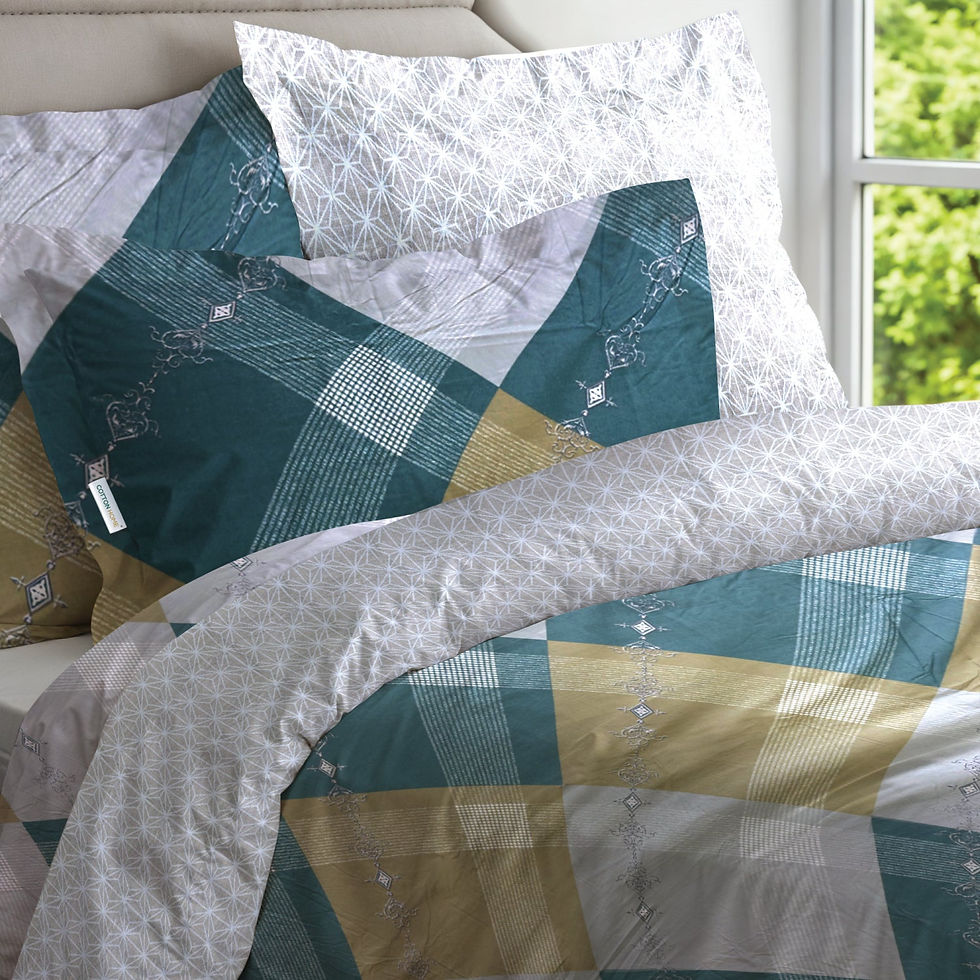Waterproof vs. Non-Waterproof Mattress Protectors: What’s Right for You?
- Cotton Home
- Jul 17
- 3 min read
Your mattress is one of the most important investments you make for your sleep and overall well-being. To keep it in top condition, a mattress protector is a must-have. But when choosing between a waterproof and a non-waterproof mattress protector, many people are unsure which one is best for their needs.
Both types come with unique benefits, and the right choice often depends on your lifestyle, health considerations, and personal preferences. In this guide, we’ll break down the differences between waterproof and non-waterproof mattress protectors and help you decide what’s right for you.
What Is a Mattress Protector?
A mattress protector is a removable layer that fits over your mattress like a fitted sheet or encasement. It protects your mattress from spills, stains, allergens, sweat, and general wear and tear. Some offer additional features such as cooling, breathability, or extra comfort.
The most important factor when choosing a protector is whether it’s waterproof or non-waterproof—and that decision can have a big impact on your sleep experience and the lifespan of your mattress.

Waterproof Mattress Protectors
What They Are:
Waterproof mattress protectors are designed with a special barrier (usually polyurethane or vinyl) that prevents liquids from penetrating through to the mattress. This makes them ideal for protecting against spills, sweat, accidents, and other moisture-related issues.
Pros:
Total Protection from Spills & Accidents: Ideal for families with kids, elderly members, or pets.
Prevents Mold and Mildew: Stops moisture from seeping into the mattress, preventing the growth of bacteria or mold.
Extends Mattress Life: Keeps the mattress dry and hygienic, increasing its durability.
Good for Allergy Sufferers: Many waterproof protectors also block dust mites and allergens.
Cons:
Can Feel Less Breathable: Some waterproof layers may trap heat or feel less soft compared to non-waterproof options (though many newer designs solve this with breathable top layers).
Might Be Noisy: Lower-quality protectors can make a crinkling sound due to the waterproof layer.
Best For:
Families with young children
Pet owners
People who sweat heavily
Individuals with incontinence or medical conditions
Anyone prone to spilling beverages in bed
Non-Waterproof Mattress Protectors
What They Are:
Non-waterproof protectors focus on enhancing comfort and offering basic protection from dust, dirt, and minor wear. They typically lack a moisture-resistant barrier, which means they won’t guard against spills or accidents.
Pros:
Soft and Breathable: Often made with natural materials like cotton, bamboo, or wool, providing a cooler and more comfortable sleeping experience.
Silent and Lightweight: These protectors tend to be quieter and less noticeable on the bed.
Eco-Friendly Options: Many non-waterproof protectors are available in organic and sustainable materials.
Cons:
No Protection Against Liquids: Not suitable for spill-prone households or those with specific health needs.
Limited Defense Against Allergens: May allow dust mites and allergens to settle in the mattress unless specifically designed to prevent them.
Best For:
Adults without spill or accident concerns
Hot sleepers who prioritize airflow and breathability
People who want a natural or eco-conscious sleep setup
Guest beds or low-traffic rooms
Key Comparison: Waterproof vs. Non-Waterproof
Feature | Waterproof | Non-Waterproof |
Liquid Protection | ✅ Excellent | ❌ None |
Breathability | ⚠️ May vary | ✅ High |
Comfort | ⚠️ Depends on fabric | ✅ Often Softer |
Allergens & Dust Mites | ✅ Blocks most | ⚠️ Limited |
Noise | ⚠️ Some may rustle | ✅ Silent |
Ideal For | Families, health needs | Adults, eco-conscious users |
Additional Features to Look For
Regardless of whether you choose waterproof or non-waterproof, consider these features for added comfort and convenience:
Hypoallergenic Material: Especially important for allergy sufferers.
Machine Washable: Easy to clean and maintain.
Fitted or Zippered Design: Fitted protectors are easier to remove; zippered ones offer full encasement.
Cooling Technology: Gel-infused or breathable fabrics can help regulate body temperature.
Warranty or Guarantee: A sign of quality and long-term support.
How to Decide What’s Right for You
Here are a few questions to ask yourself before choosing:
Do you eat or drink in bed regularly?→ Go for a waterproof protector.
Do you sweat a lot during sleep or live in a hot climate?→ A breathable non-waterproof protector might be more comfortable.
Do you have kids, pets, or elderly family members at home?→ You’ll benefit from waterproof protection.
Are you trying to create a natural or organic sleep environment?→ Choose a non-waterproof option made with organic cotton or bamboo.
Do you suffer from allergies or asthma?→ Waterproof options that also block allergens offer dual protection.
Conclusion
Choosing between a waterproof and non-waterproof mattress protector depends on your lifestyle, health needs, and comfort preferences. If protection from spills, allergens, or moisture is your priority, waterproof is the way to go. If comfort, breathability, and eco-friendliness matter more—and spills aren’t a concern—a non-waterproof protector may suit you better.
In either case, a mattress protector is a smart investment that protects your sleep quality and prolongs the life of your mattress. Make your choice wisely, and you’ll sleep better knowing your bed is clean, comfortable, and tailored to your needs.





Comments